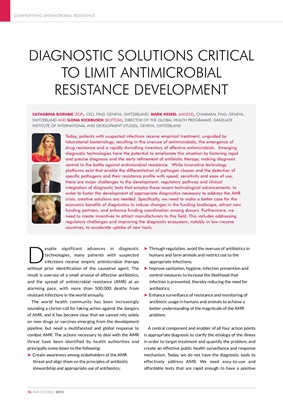
CONFRONTING ANTIMICROBIAL RESISTANCE
76 AMR CONTROL 2015
D
espite significant advances in diagnostic
technologies, many patients with suspected
infections receive empiric antimicrobial therapy
without prior identification of the causative agent. The
result is overuse of a small arsenal of effective antibiotics,
and the spread of antimicrobial resistance (AMR) at an
alarming pace, with more than 500,000 deaths from
resistant infections in the world annually.
The world health community has been increasingly
sounding a clarion call for taking action against the dangers
of AMR, and it has become clear that we cannot rely solely
on new drugs or vaccines emerging from the development
pipeline, but need a multifaceted and global response to
combat AMR. The actions necessary to deal with the AMR
threat have been identified by health authorities and
principally come down to the following:
‰ Create awareness among stakeholders of the AMR
threat and align them on the principles of antibiotic
stewardship and appropriate use of antibiotics;
‰ Through regulation, avoid the overuse of antibiotics in
humans and farm animals and restrict use to the
appropriate infections;
‰ Improve sanitation, hygiene, infection prevention and
control measures to increase the likelihood that
infection is prevented, thereby reducing the need for
antibiotics;
‰ Enhance surveillance of resistance and monitoring of
antibiotic usage in humans and animals to achieve a
better understanding of the magnitude of the AMR
problem.
A central component and enabler of all four action points
is appropriate diagnosis to clarify the etiology of the illness
in order to target treatment and quantify the problem, and
create an effective public health surveillance and response
mechanism. Today, we do not have the diagnostic tools to
effectively address AMR. We need easy-to-use and
affordable tests that are rapid enough to have a positive
DIAGNOSTIC SOLUTIONS CRITICAL
TO LIMIT ANTIMICROBIAL
RESISTANCE DEVELOPMENT
CATHARINA BOEHME (TOP), CEO, FIND, GENEVA, SWITZERLAND; MARK KESSEL (MIDDLE), CHAIRMAN, FIND, GENEVA,
SWITZERLAND AND ILONA KICKBUSCH (BOTTOM), DIRECTOR OF THE GLOBAL HEALTH PROGRAMME, GRADUATE
INSTITUTE OF INTERNATIONAL AND DEVELOPMENT STUDIES, GENEVA, SWITZERLAND
Today, patients with suspected infections receive empirical treatment, unguided by
laboratorial bacteriology, resulting in the overuse of antimicrobials, the emergence of
drug resistance and a rapidly dwindling inventory of effective antimicrobials. Emerging
diagnostic technologies have the potential to ameliorate this situation by fostering rapid
and precise diagnosis and the early refinement of antibiotic therapy, making diagnosis
central to the battle against antimicrobial resistance. While innovative technology
platforms exist that enable the differentiation of pathogen classes and the detection of
specific pathogens and their resistance profile with speed, sensitivity and ease of use,
there are major challenges to the development, regulatory pathway and clinical
integration of diagnostic tests that employ these recent technological advancements. In
order to foster the development of appropriate diagnostics necessary to address the AMR
crisis, creative solutions are needed. Specifically, we need to make a better case for the
economic benefits of diagnostics to induce changes in the funding landscape, attract new
funding partners, and enhance funding coordination among donors. Furthermore, we
need to create incentives to attract manufacturers to this field. This includes addressing
regulatory challenges and improving the diagnostic ecosystem, notably in low-income
countries, to accelerate uptake of new tools.